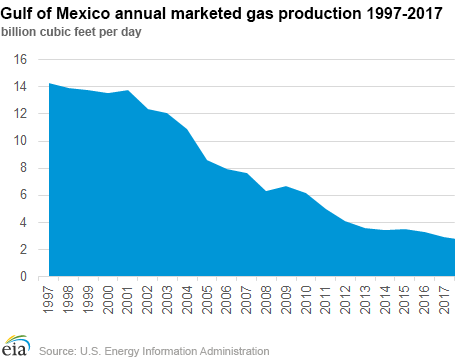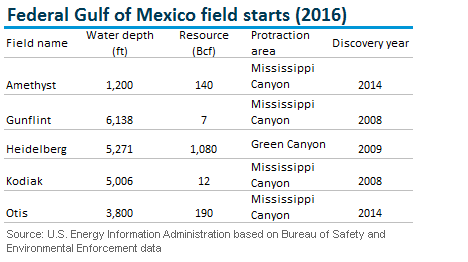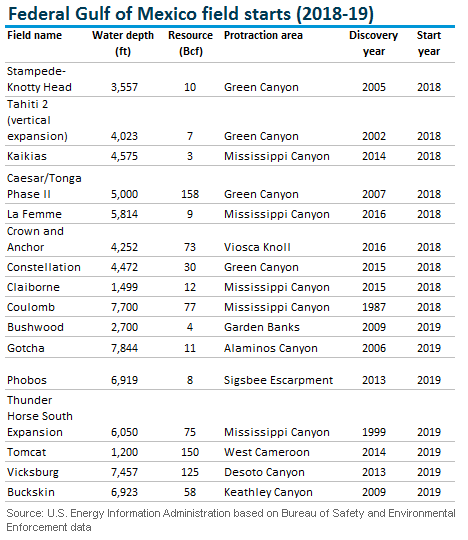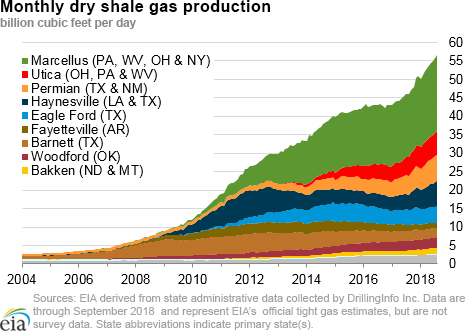In the News:
New Gulf of Mexico projects expected to reverse natural gas production declines
Natural gas production in the U.S. Federal Gulf of Mexico (GOM) has been declining for almost two decades. EIA expects nine new natural gas production projects to start in 2018 and another seven to start in 2019. These 16 projects have a combined estimated natural gas resource of about 800 billion cubic feet and may reverse some of the declines in GOM production.
The GOM marketed natural gas production has been mostly declining on an annual basis since 1997, when EIA first recorded this data. In 1997, production stood at 14.3 billion cubic feet per day (Bcf/d), accounting for 26% of the United States’ total annual marketed natural gas production. By 2017, natural gas production in GOM declined to 2.9 Bcf/d and accounted for only 4% of the total U.S. annual marketed production.
This decline occurred for several reasons. The number of producing natural gas wells in the GOM declined by 73% between 2001 and 2017—from 3,271 to 875. The technology and expertise required to produce oil and natural gas from the seabed is expensive and specialized, and costs of production platforms often exceed a billion dollars. With the growth in exploration and production activities in shale gas and tight oil formations, it became more economic to drill onshore in these basins.
In addition, most of the natural gas produced in the GOM is associated-dissolved (AD) natural gas produced from oil fields, and although older oil wells in the GOM tend to have higher natural gas content, newer wells are more oil-rich, resulting in less AD natural gas per well. According EIA’s Natural Gas Annual, 59% of gross withdrawals of natural gas in the GOM were from oil wells in 2017. In 1997, however, only 13% of gross withdrawals were of AD gas co-produced with oil.
In 2016, all new projects in the GOM occurred in the Mississippi Canyon and Green Canyon protraction areas, located in the Central GOM planning area, and had an average depth of 4,283 feet and total resource level of 1,429 Bcf. Based on the data provided to the Bureau of Safety and Environmental Enforcement, no new GOM projects started up in 2017. For 2018–19, 9 of the 16 projects are located in Mississippi Canyon and Green Canyon protraction areas. Three projects in Garden Banks, West Cameron, and Keathley Canyon are also part of the Central GOM planning area. Two of the projects in Viosca Knoll and Desoto Canyon are in the Eastern GOM planning area. Alaminos Canyon and Sigsbee Escarpment are in the Western GOM planning area. Average project depth is expected to be 4,544 feet in 2018 and 5,585 feet in 2019.
Overview:
(For the Week Ending Wednesday, November 1, 2018)
- Natural gas spot prices fell at most locations this report week (Wednesday, October 24 to Wednesday, October 31). Henry Hub spot prices fell from $3.36 per million British thermal units (MMBtu) last Wednesday to $3.29/MMBtu yesterday.
- At the New York Mercantile Exchange (Nymex), the November 2018 contract expired Monday at $3.185/MMBtu. The December 2018 contract price increased to $3.261/MMBtu, up 3¢/MMBtu Wednesday to Wednesday.
- Net injections to working gas totaled 48 Bcf for the week ending October 26. Working natural gas stocks are 3,143 Bcf, which is 17% lower than the year-ago level and 17% lower than the five-year (2013–17) average for this week.
- The natural gas plant liquids composite price at Mont Belvieu, Texas, fell by 66¢/MMBtu, averaging $7.95/MMBtu for the week ending October 31. The price of natural gasoline, ethane, propane, butane, and isobutane all fell, by 6%, 11%, 7%, 7%, and 5%, respectively.
- According to Baker Hughes, for the week ending Tuesday, October 23, the natural gas rig count decreased by 1 to 193. The number of oil-directed rigs rose by 2 to 875. The total rig count increased by 1, and it now stands at 1,068. This count is the highest total rig count since March 2015.
Prices/Supply/Demand:
Spot prices fall across the country. This report week (Wednesday, October 24 to Wednesday, October 31), Henry Hub spot prices fell 7¢ from $3.36/MMBtu last Wednesday to $3.29/MMBtu yesterday, with a low of $3.17/MMBtu on Monday. At the Chicago Citygate, prices decreased 42¢ from $3.53/MMBtu last Wednesday to $3.11/MMBtu yesterday as temperatures in the Midwest warmed. Prices at PG&E Citygate in Northern California fell 58¢, down from $4.36/MMBtu last Wednesday to $3.78/MMBtu yesterday. Prices at SoCal Citygate were an exception, increasing $1.01 from $4.48/MMBtu last Wednesday to $5.49/MMBtu yesterday as unseasonably warm temperatures were forecast in the region over the next few days.
Prices at the Waha Hub in West Texas, which is located near Permian Basin production activities, averaged $1.90/MMBtu last Wednesday, $1.46/MMBtu lower than Henry Hub prices. Yesterday, prices at the Waha Hub averaged $1.56/MMBtu, $1.73/MMBtu lower than Henry Hub prices.
Northeast prices decrease. Northeast prices saw large declines as temperatures warmed from the first half of the report week. At the Algonquin Citygate, which serves Boston-area consumers, prices went down $1.31 from $4.21/MMBtu last Wednesday to $2.90/MMBtu yesterday. At the Transcontinental Pipeline Zone 6 trading point for New York City, prices decreased 74¢ from $3.49/MMBtu last Wednesday to $2.75/MMBtu yesterday.
Tennessee Zone 4 Marcellus spot prices decreased 55¢ from $3.21/MMBtu last Wednesday to $2.66/MMBtu yesterday. Prices at Dominion South in southwest Pennsylvania fell 48¢ from $3.17/MMBtu last Wednesday to $2.69/MMBtu yesterday.
Enbridge outage continues to affect Sumas prices. Prices at Sumas on the Canada-Washington border fell $1.79 from $6.20/MMBtu last Wednesday to $4.41/MMBtu yesterday, with a high of $14.12/MMBtu on Monday. Prices at Sumas remain affected by the explosion on the Enbridge pipeline, which flows Canadian natural gas to Sumas. Enbridge announced yesterday that it had completed repairs on the ruptured pipeline, and the pipeline would return to service by the end of the week.
November Nymex contract expires up, while December contract rises. At the Nymex, the November 2018 contract expired Monday at $3.185/MMBtu, up 2¢/MMBtu from last Wednesday. The December 2018 contract increased to $3.261/MMBtu, up 3¢/MMBtu from last Wednesday to yesterday. The price of the 12-month strip averaging December 2018 through November 2019 futures contracts remained the same Wednesday to Wednesday at $2.842/MMBtu.
Supply remains flat despite continuing production growth. According to data from PointLogic Energy, the average total supply of natural gas remained the same as in the previous report week, averaging 91.1 Bcf/d. Dry natural gas production grew by 1% compared with the previous report week. Average net imports from Canada decreased by 15% from last week and were 33% lower than last year at this time.
Demand falls. Total U.S. consumption of natural gas fell by 1% compared with the previous report week, according to data from PointLogic Energy. Natural gas consumed for power generation declined by 2% week over week. Industrial sector consumption stayed constant, averaging 22.5 Bcf/d. In the residential and commercial sectors, consumption declined by 1%. Natural gas exports to Mexico decreased 3%, but they were 13% higher than last year at this time.
U.S. liquefied natural gas (LNG) exports increase week over week. Seven LNG vessels (five from the Sabine Pass liquefaction terminal and two from Cove Point) with a combined LNG-carrying capacity of 24.5 Bcf departed the United States between October 25 and October 31. One LNG tanker (capacity 3.8 Bcf) was loading at Sabine Pass on Wednesday. The two cargoes exported from the Cove Point terminal were the first exports since the facility resumed LNG production after three weeks of scheduled maintenance that was completed in mid-October.
The first LNG export from the new Corpus Christi liquefaction terminal located in Texas is now expected in mid-November, according to Bloomberg, as the facility continues its commissioning activities.
Storage:
Net injections are lower than the five-year average. Net injections into storage totaled 48 Bcf for the week ending October 26, compared with the five-year (2013–17) average net injections of 62 Bcf and last year's net injections of 65 Bcf during the same week. Working gas stocks totaled 3,143 Bcf, which is 638 Bcf lower than the five-year average and 623 Bcf lower than last year at this time.
Working gas stocks’ deficit to the five-year average increases, and the deficit to the bottom of the five-year range also increases. The average rate of net injections into storage is 14% lower than the five-year average so far in this refill season (April through October). If the rate of injections into storage matched the five-year average for the remainder of the refill season, total inventories would be 3,177 Bcf on October 31, which is 638 Bcf lower than the five-year average of 3,815 Bcf for that time of year. In the Lower 48 states, total working gas stocks are currently 363 Bcf lower than the five-year minimum, and every storage region is currently lower than the bottom of the five-year range. The deficit to the bottom of the range increased in the Midwest region and the South Central region. As of this report week, the Midwest region is 76 Bcf (7%) lower than the five-year minimum, and the South Central region―including both salt and non-salt facilities―is 144 Bcf (14%) lower than the five-year minimum.
The average January 2019 futures contract price is trading at a lower premium to the average spot price than last year at this time. Price differences between the spot price and the futures price at the Nymex indicate limited economic incentives for injections into working gas. During the most recent storage week, the average natural gas spot price at the Henry Hub averaged $3.26/MMBtu, and the Nymex futures price of natural gas for delivery in January 2019 averaged $3.33/MMBtu, 7¢/MMBtu higher than the spot price. A year ago, the January contract was 37¢/MMBtu higher than the spot price.
Reported net injections into storage are within the range of analysts’ expectations. According to The Desk survey of natural gas analysts, estimates of the weekly net change from working natural gas storage ranged from net injections of 37 Bcf to 60 Bcf, with a median estimate of 51 Bcf. At the 10:30 a.m. release of the Weekly Natural Gas Storage Report, the price of the Nymex futures contract for November delivery at the Henry Hub rose 1¢/MMBtu to $3.29/ MMBtu, with only 233 trades executed. The price varied in subsequent trading, averaging $3.28/MMBtu.
Temperatures were significantly cooler than normal for the storage week. Temperatures in the Lower 48 states averaged 52 degrees Fahrenheit (°F), 2°F lower than normal and 8°F lower than last year at this time. Temperatures were 2°F lower than those reported for the previous week.
See also:
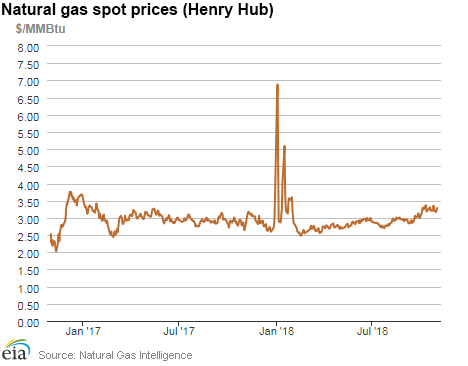
| Spot Prices ($/MMBtu) | Thu, 25-Oct |
Fri, 26-Oct |
Mon, 29-Oct |
Tue, 30-Oct |
Wed, 31-Oct |
|---|---|---|---|---|---|
| Henry Hub | 3.32 | 3.20 | 3.17 | 3.22 | 3.29 |
| New York | 3.32 | 3.13 | 3.21 | 2.98 | 2.75 |
| Chicago | 3.40 | 3.29 | 3.17 | 3.18 | 3.11 |
| Cal. Comp. Avg.* | 3.48 | 3.45 | 3.42 | 3.31 | 3.26 |
| Futures ($/MMBtu) | |||||
| November Contract | 3.202 | 3.185 | 3.185 | Expired | Expired |
| December Contract | 3.256 | 3.225 | 3.198 | 3.187 | 3.261 |
| January Contract | 3.317 | 3.290 | 3.261 | 3.244 | 3.302 |
| *Avg. of NGI's reported prices for: Malin, PG&E Citygate, and Southern California Border Avg. | |||||
| Source: Natural Gas Intelligence | |||||
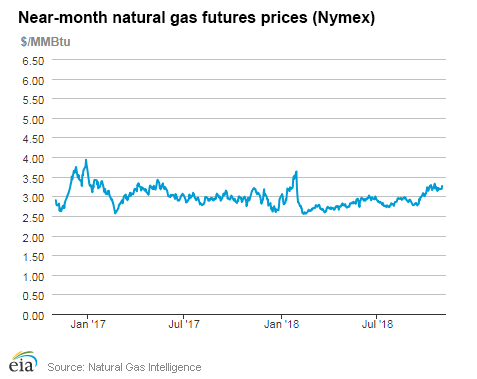
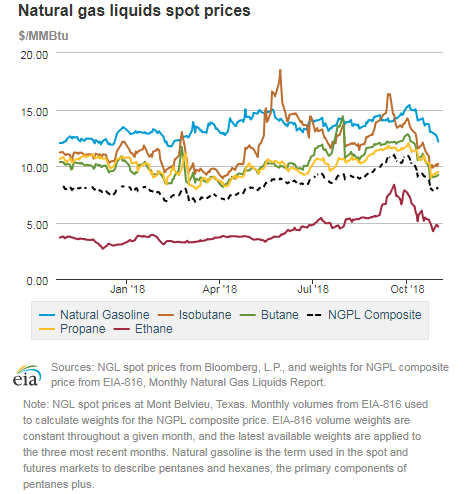
| U.S. natural gas supply - Gas Week: (10/25/18 - 10/31/18) | |||
|---|---|---|---|
Average daily values (Bcf/d): |
|||
this week |
last week |
last year |
|
| Marketed production | 98.0 |
97.3 |
86.2 |
| Dry production | 87.3 |
86.6 |
77.9 |
| Net Canada imports | 3.7 |
4.4 |
5.6 |
| LNG pipeline deliveries | 0.1 |
0.1 |
0.1 |
| Total supply | 91.1 |
91.1 |
83.5 |
|
Source: OPIS PointLogic Energy, an IHS Company | |||
| U.S. natural gas consumption - Gas Week: (10/25/18 - 10/31/18) | |||
|---|---|---|---|
Average daily values (Bcf/d): |
|||
this week |
last week |
last year |
|
| U.S. consumption | 67.7 |
68.5 |
66.0 |
| Power | 23.3 |
23.9 |
22.5 |
| Industrial | 22.5 |
22.4 |
22.3 |
| Residential/commercial | 21.9 |
22.2 |
21.2 |
| Mexico exports | 4.8 |
4.9 |
4.2 |
| Pipeline fuel use/losses | 7.4 |
7.5 |
7.2 |
| LNG pipeline receipts | 3.8 |
3.7 |
3.1 |
| Total demand | 83.7 |
84.6 |
80.6 |
|
Source: OPIS PointLogic Energy, an IHS Company | |||
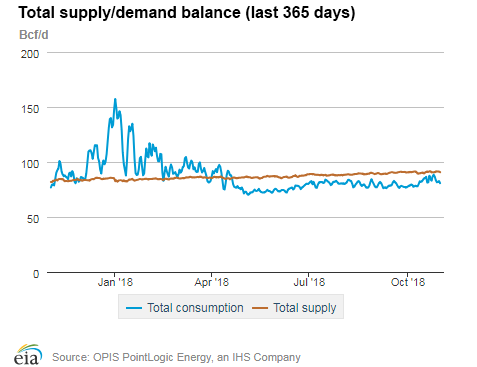
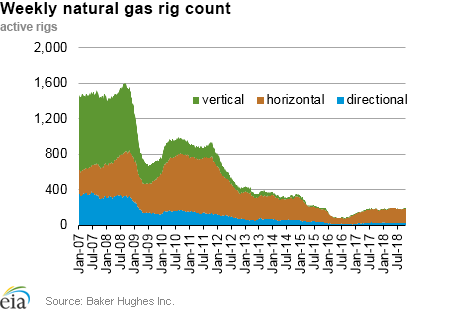
| Rigs | |||
|---|---|---|---|
Tue, October 23, 2018 |
Change from |
||
last week |
last year |
||
| Oil rigs | 875 |
0.2% |
18.7% |
| Natural gas rigs | 193 |
-0.5% |
12.2% |
| Note: Excludes any miscellaneous rigs | |||
| Rig numbers by type | |||
|---|---|---|---|
Tue, October 23, 2018 |
Change from |
||
last week |
last year |
||
| Vertical | 68 |
-1.4% |
3.0% |
| Horizontal | 927 |
0.1% |
20.5% |
| Directional | 73 |
1.4% |
-1.4% |
| Source: Baker Hughes Inc. | |||
| Working gas in underground storage | ||||
|---|---|---|---|---|
Stocks billion cubic feet (Bcf) |
||||
| Region | 2018-10-26 |
2018-10-19 |
change |
|
| East | 826 |
825 |
1 |
|
| Midwest | 956 |
934 |
22 |
|
| Mountain | 180 |
177 |
3 |
|
| Pacific | 262 |
262 |
0 |
|
| South Central | 919 |
896 |
23 |
|
| Total | 3,143 |
3,095 |
48 |
|
|
Source: Form EIA-912, "Weekly Underground Natural Gas Storage Report" | ||||
| Working gas in underground storage | |||||
|---|---|---|---|---|---|
Historical comparisons |
|||||
Year ago (10/26/17) |
5-year average (2013-2017) |
||||
| Region | Stocks (Bcf) |
% change |
Stocks (Bcf) |
% change |
|
| East | 924 |
-10.6 |
913 |
-9.5 |
|
| Midwest | 1,103 |
-13.3 |
1,078 |
-11.3 |
|
| Mountain | 226 |
-20.4 |
218 |
-17.4 |
|
| Pacific | 317 |
-17.4 |
349 |
-24.9 |
|
| South Central | 1,195 |
-23.1 |
1,223 |
-24.9 |
|
| Total | 3,766 |
-16.5 |
3,781 |
-16.9 |
|
| Source: Form EIA-912, "Weekly Underground Natural Gas Storage Report" | |||||
| Temperature – heating & cooling degree days (week ending Oct 25) | ||||||||
|---|---|---|---|---|---|---|---|---|
HDD deviation from: |
CDD deviation from: |
|||||||
| Region | HDD Current |
normal |
last year |
CDD Current |
normal |
last year |
||
| New England | 146 |
31 |
109 |
0 |
0 |
0 |
||
| Middle Atlantic | 130 |
25 |
91 |
0 |
0 |
0 |
||
| E N Central | 148 |
36 |
82 |
0 |
-1 |
0 |
||
| W N Central | 127 |
15 |
56 |
0 |
-1 |
0 |
||
| South Atlantic | 84 |
23 |
47 |
25 |
4 |
-3 |
||
| E S Central | 82 |
22 |
35 |
2 |
-4 |
-2 |
||
| W S Central | 42 |
16 |
19 |
10 |
-12 |
-19 |
||
| Mountain | 77 |
-30 |
-2 |
11 |
4 |
-4 |
||
| Pacific | 15 |
-29 |
-12 |
4 |
0 |
-15 |
||
| United States | 95 |
12 |
48 |
7 |
-1 |
-6 |
||
|
Note: HDD = heating degree day; CDD = cooling degree day Source: National Oceanic and Atmospheric Administration | ||||||||
Average temperature (°F)
7-Day Mean ending Oct 25, 2018
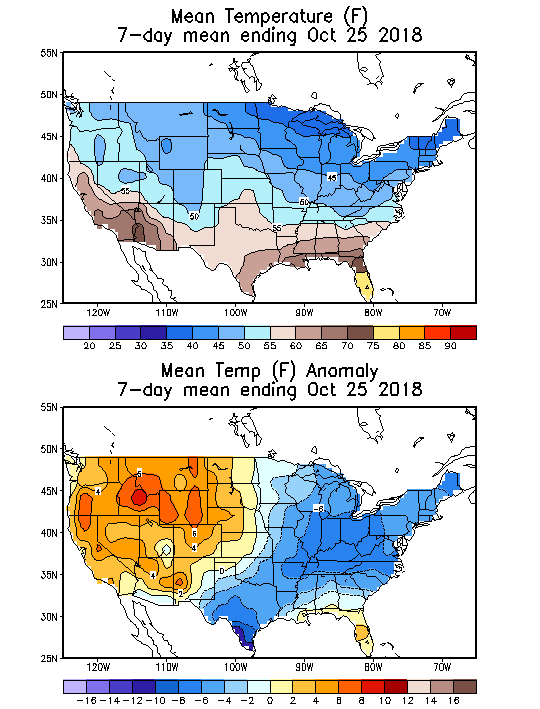
Source: NOAA National Weather Service
Deviation between average and normal (°F)
7-Day Mean ending Oct 25, 2018

Source: NOAA National Weather Service

